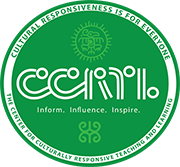
Journey To Responsiveness
WHAT IT MEANS TO BE CLR:
CLR is going where the students are culturally and linguistically, for the purpose of bringing them where they need to be academically.
CLR is the opposite of the sink-or-swim approach to teaching and learning or traditional schooling.
Ultimately, CLR is a challenge to your existing pedagogy. Becoming culturally responsive means that your instruction changes for the better. CLR can renovate or overhaul your instruction, depending on where you are in your teaching and where you want to be at the end of the day. CLR is rooted in seeing and feeling the change for yourself. In other words, you can see the difference without any external endorsement or research, because you know that it feels right.
CLR revolution happens in two ways: a change in mindset and in skillset. Focus on Culture and its Instructional Benefits, our required foundational professional development workshop, in addition to our two books referenced above, begins the long journey to cultural responsiveness by introducing CLR pedagogy and challenging our current mindset. It is important that these resources are introduced and revisited before diving into the CLR pool of activities. CLR skillset is developed through our Culturally Responsive workshop series, Jumpstart workshop and throughout our instructional coaching rounds.
SKILLSET VS. MINDSET
The first way is the change in mindset. As the initial step to changing the instructional dynamic in the classroom and the overall school climate, educators have to see their students’ cultural and linguistic behaviors. A change in mindset is rooted in four areas: speaking a common language, listening to your deficit monitor, knowing your race-ethno cultural identity, and identifying the students who are in most need of cultural responsiveness.
The second way the journey to responsiveness happens, is in the change in skillset. Skillset means a culturally responsive use of a set of strategies and activities that validates, affirms, builds, and bridges (VABB). Similar to the mindset piece, skillset is rooted in four aspects: knowing the gatekeepers of success, using traditional to responsive to culturally responsive instruction, jumping into the pool of responsive activities, and re-imaging the learning environment. Understanding the skillset in brief, enables us to examine how the change in mindset is associated with the skillset.

CLR POOL OF ACTIVITIES
As mentioned previously, U.S. schooling is based on the sink‑or‑swim approach. You have some students who are simply good swimmers, meaning they “do” school well. On the other hand, you have some students who are not good swimmers or are not swimmers at all. These students don’t do school “well.” In order to reach those students who are not good swimmers or non-swimmers, you are going to have to jump in the pool with them and not stand on the side of the pool. CLR is metaphorically diving into the pool and getting into the water with your students; you are meeting your students where they are culturally and linguistically.
Our organization has identified four broad pedagogical areas and the learning environment that can be infused with CLR strategies and activities. These activity categories are identified, along with the associated pedagogical areas, below:
These pedagogical areas represent the general categories that we believe all classrooms—regardless of grade level or content area—should have in place effectively and efficiently, therefore, we created Culturally Responsive workshops that build off of these categories. We include the term responsive in the label for each category to ensure that instruction centers on culturally and linguistically appropriate activities.
These categories are the basis for instructional failure or success. CLR does not replace or shield ineffective instruction. At times, administrators will send so-called “bad” or ineffective teachers to our trainings, thinking that these teachers can be turned into “good” teachers through CLR. This is asking too much of the approach. CLR can make a difference for many inadequacies in instruction, but when the fundamentals are not effectively in place, using CLR is like putting a new suit on a dirty body. To be most effective with CLR, we have to make sure the body is clean first, meaning that educators should make sure the fundamentals are effectively in place.



